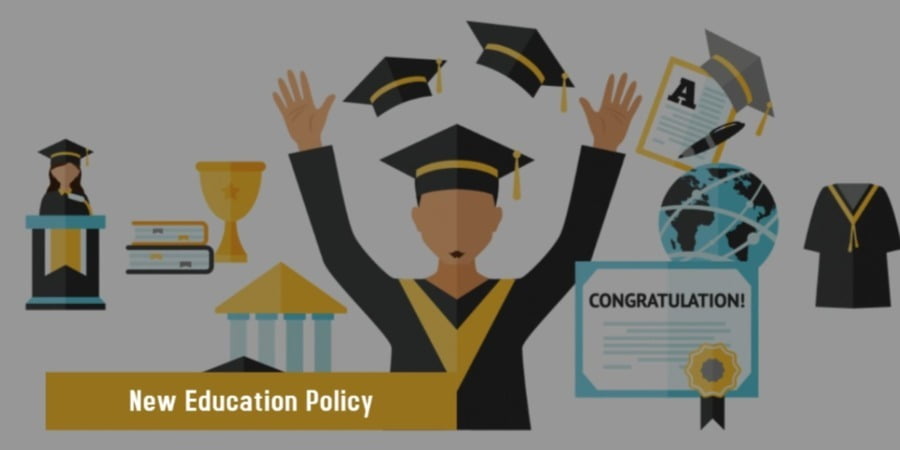
It is very clear that shortly new Education Policy will be implemented all over India. The committee headed by renowned scientist Dr K Kasturirangan to formulate the draft of new Education Policy has submitted its report. The key question is whether there is a need for a new education policy. It is undoubtedly true that what has so far happened in education sector leaves a lot to be desired. However, whether the dismal performance is on account of a policy gap, or other factors are responsible for the current state of affairs remains to be seen. Drawing inputs from the TSR Subramanian Committee Report and the Ministry of Human Resource Development (MHRD), the Kasturirangan Committee has produced a document that is comprehensive, far-sighted and grounded in realities.
Two things have certainly happened during the current millennium. The infrastructure (school buildings) has certainly shown remarkable improvement though there is still a long way to go. And, thanks to the mid-day meal, we have managed to get the child to the school. However, what is appalling is the poor quality of education that is imparted in most of the government schools. This is evidenced by the fact that the learning outcomes have actually come down during the past decade despite an enormous amount of investments. The number of teachers has gone up substantially and the average student-teacher ratio comes close to the required levels. However, this does not solve the problem of quality. To begin with, a large number of teachers are not qualified to teach, yet they are teaching. According to a rough estimate, out of 8 million teachers, around 1.4 million falls in this category. Politics has seeped into this cadre in the most insidious manner resulting in a skewed distribution of teachers in most of the states as the tendency is to hang in and around urban areas. The idea that lifelong education is based on four pillars—learning to know, learning to do, learning to live together and learning to be — has inspired the committee to cover every aspect of the education sector: school, higher, vocational and adult education. It also includes the whole gamut of professional education — engineering, medicine, agriculture, law, etc. It explains the scientific rationale behind the policy’s prescriptions and suggests how the proposals can be translated into practice at the State and Central levels.
The draft policy seeks to revamp all aspects of the sector and does not shy away from suggesting brave new ideas. In school education, one such idea is to cover children of 3-18 years (instead of the present 6-14 years under the Right to Education (RTE) Act, three years under early childhood care and education (ECCE) and four years under secondary education. Based on evidence from neuroscience that over 85 per cent of a child’s cumulative brain development occurs prior to the age of six and that ‘school preparedness’ at Anganwadis is light on educational aspects, ECCE would facilitate play and discovery-based learning for children of that age group.
Another innovative idea is to achieve ‘universal foundational literacy and numeracy’ through initiatives like the National Tutors Programme and the Remedial Instructional Aides Programme. Introduction of school complexes, a system of modular Board Examinations to allow flexibility, setting up Special Education Zones in disadvantaged regions, recognizing teachers at the heart of the system, moving teacher education into the university system, and stressing the importance of learning new languages are among the key recommendations. The Right to Education Act did precious little to salvage this. In fact, in some cases, like the no-detention policy and the mandatory provision relating to qualification and number of teachers, it created more problems than it solved. A tedious process of the amendment had to be resorted to correct some of the wrongs.
Most of the action relating to education lies with the states. In any case, the country is too diverse to consider a single mandate by way of policy for the entire country. If a teacher does not go to a school in Kerala, he could well be ‘lynched’, but in some of the states of northern India, they consider it their right not to go to the school. There are instances of these regular teachers employing a ‘substitute’ to represent them and even teach on their behalf. Can a policy solve the problems that beset this sector? In fact, as mentioned above, problems vary from region to region. In any case, if policies were to solve the problems of the country, they would have been solved long ago. There should be just a short policy statement outlining the objectives: Providing quality education to every child in the country. What is actually required is an action plan clearly outlining: What needs to be done? How it will be done? Who will do it? And, by when it will be done? The roles of respective entities should be clearly defined so that performance can be assessed. One has often wondered why should only the Central government assess the performance of states? Why can’t it be the other way round?
These are progressive ideas, but there are roadblocks in their implementation. These mostly relate to funding requirements and governance architecture.
First, what is recommended is a doubling of public funding to 6% of the GDP and increasing overall public expenditure on education to 20% from the current 10%. This is desirable but does not appear to be feasible in the near future given that most of the additional funding has to come from the States.
Second, while establishing new institutions for Pali, Prakrit and Persian appears to be a novel idea, shouldn’t the Central Institute of Indian Languages in Mysuru be strengthened and perhaps even upgraded to a university with an extended mandate to take care of these languages?
Third, expanding coverage under the RTE Act to include pre-school children is extremely important, but it should perhaps be introduced gradually, keeping in mind the quality of infrastructure and teacher vacancies. Amendment of the Act can perhaps wait for a while.
Fourth, the idea of setting up the Rashtriya Shiksha Aayog under the Prime Minister and having it serviced by the MHRD is crucial in order to integrate the approaches and programmes of multiple departments. However, it is fraught with many administrative problems and possible turf battles.
Fifth, the idea of regulation being brought under the National Higher Education Regulatory Authority, standard-setting under the General Education Council and funding under the Higher Education Grants Council may require a revisit so that there is synchronization with the current Bill for the Higher Education Commission of India.
Last, language issues have to be handled sensitively in view of their emotional overtones, as witnessed recently. Protests are often made without understanding the spirit of the text. The details about financing and institutional structures should be fleshed out at the earliest, perhaps by an inter-departmental committee under the Cabinet Secretary.
Our country has been obsessed with the western world. We had looked at Finland, England, Scotland, Holland and all the lands of the world but not at motherland. A lot of wonderful work is being done within the country but has so far gone unnoticed. “Policy” cannot help in this regard. What needs to be done is to facilitate the identification, understanding and scaling of successful practices. If these homegrown practices have succeeded in the prevalent objective conditions, the chances of their replication and scaling are pretty high as compared to an ‘imported’ idea or practice. What is also required is imparting of learning from states that have turned it around through some remarkable state-level interventions, both administrative and financial. Policy debates provide food for intellectual stimulation but what matters is what is done on the ground. Hence, the dire need for an action plan. Every Indian wants a new education policy of the people, by the people, and for the people.
[“source=sentinelassam”]







